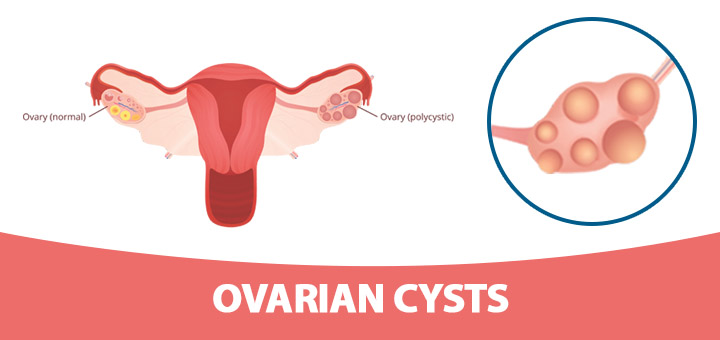An ovarian cyst is a sack like structure filled with either liquid, gaseous, or semi-solid material. Ovarian cysts can be small or large, but a majority of them are small and harmless. Most ovarian cysts cause no symptoms and disappear within a few months, however a large ovarian cyst can cause fullness or heaviness in the abdomen, pelvic pain, and bloating. Depending on their type, some ovarian cysts can cause fertility problems. Ovarian cysts are of two types: physiologic (functional) and pathologic.
PHYSIOLOGIC (FUNCTIONAL) OVARIAN CYSTS
Cysts developed during menstrual period as part of ovulation cycle are physiologic or functional cysts. These cysts are harmless, cause no symptoms, and go away on their own in a few months. There are two types of physiologic or functional cysts:
- Follicular Cyst: Usually the follicle burst and releases the egg, which travels down the fallopian tube. A follicular cyst starts growing when the follicle fails to burst or rupture to release its egg.
- Corpus Luteum Cyst: The follicle begins producing estrogen and progesterone for conception after releasing the egg. This follicle, which at this stage is called corpus luteum, sometimes grow into a cyst due to accumulation of fluid inside.
PATHOLOGIC OVARIAN CYSTS
Ovarian cysts that develop in the ovary, but are not part of the ovulation cycle are called “pathologic ovarian cysts. There four types of pathologic cysts.
- Dermoid Cysts: Dermoid cysts are also called teratomas. These cysts are formed from embryonic cells and contain tissue, such as hair, skin or teeth. Dermoid cysts sometimes become large pushing the ovary out of its normal position. This causes ovarian torsion, resulting in painful twisting of your ovary. Ovarian torsion can cause stopping or decreased flow to the ovary. These cysts are not associated with any fertility problem.
- Cystadenomas: These cysts, containing watery or a mucous material, develop on the surface of an ovary. Cystadenomas sometimes become large, pushing the ovary out of its normal position. This causes ovarian torsion, resulting in painful twisting of your ovary. Ovarian torsion can cause stopping or decreased flow to the ovary. These cysts are not associated with any fertility problems.
- Endometriomas: These cysts develop when uterine endometrial cells grow outside the uterus. Sometimes a growth forms due to attachment of the tissue to the ovary. Although these endometriomas are benign cysts, they can cause fertility problems. Surgical removal of these cysts can improve fertility.

